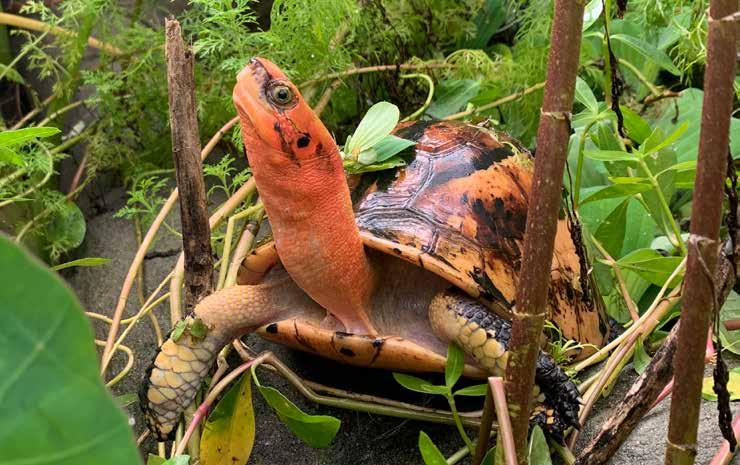Font size:
Print
Bengal Roof Turtles
Species in News : Endangered species of turtles reintroduced in Ganga river
Context: In a groundbreaking wildlife conservation effort, 20 critically endangered red-crowned roofed turtles have been reintroduced into the Ganga River in western Uttar Pradesh, marking the species’ return to the waterway after a three-decade absence.
About Bengal Roof Turtles
-
- Scientific Name: Batagur kachuga
- Common Names: Bengal roof turtle, Red-crowned roofed turtle
- Physical Characteristics:
-
-
- Female turtles: Up to 56 cm in shell length and weigh up to 25 kg
- Males: Half the size of females
- Carapace: Strongly keeled
- Plastron (underside): Angulated laterally in juveniles
- Reproduction: Females lay 11 to 30 eggs during March–April
- Range: Native to India, Bangladesh, and Nepal
- Historically widespread in the Ganga River (India and Bangladesh) and Brahmaputra basin. Listed among Asia’s 50 most endangered tortoises
- Current Wild Population: Fewer than 300 individuals, limited to the Chambal River in India.
- Habitat: Freshwater species, found in deep flowing rivers. It prefers terrestrial nesting sites along riverbanks.
- Diet: Exclusively consists of water plants.
- Conservation Status:
- IUCN: Critically Endangered
- IWPA: Schedule I (Indian Wildlife Protection Act)
- CITES: Appendix I
- U.S. ESA: Not listed
-
- Major Threats:
-
- Habitat degradation: Due to pollution, large-scale development (water extraction for irrigation, dams), and irregular flow from upstream reservoirs.
- Sand mining and agricultural activities affecting nesting sandbars along the Ganga River.
- Drowning due to illegal fishing nets.
- Poaching and illegal trade of the species.
Conservation Efforts: The Historic Reintroduction Effort
- 20 red-crowned roofed turtles have been reintroduced into the Ganga in a joint conservation effort by Namami Gange, the state forest department, and the India Turtle Conservation Program.
- The turtles, 10 males and 10 females, are 2-3 years old and have been released in two areas of the Ganga:
- Upstream, near Haiderpur Wetland
- Downstream, in the Hastinapur Wildlife Sanctuary.
- The turtles were carefully chosen based on their health, sex, and morphometric characteristics. Proper procedures, including hydration maintenance and minimising stress, were followed to ensure a successful translocation.
- The reintroduction effort will help gather important data for future conservation actions for other endangered species, with sonic transmitters attached to the turtles to monitor their movements and health.
Subscribe to our Youtube Channel for more Valuable Content – TheStudyias
Download the App to Subscribe to our Courses – Thestudyias
The Source’s Authority and Ownership of the Article is Claimed By THE STUDY IAS BY MANIKANT SINGH

